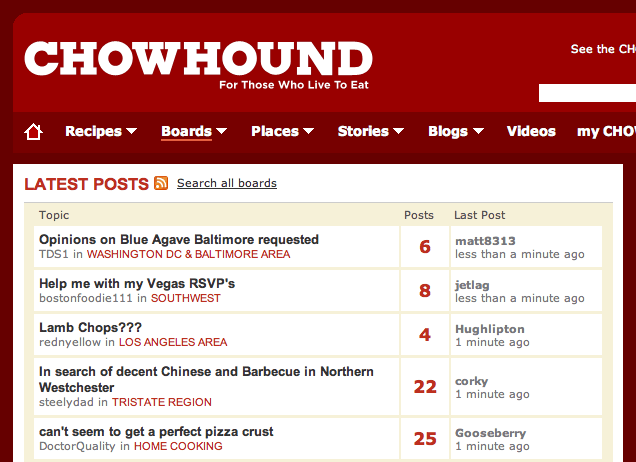Finding the primary pivot
Over time, the primary pivot of social software has shifted away from the topic thread and toward the person.
Chowhound.com is one of the most successful sites for foodies on the Web. When you visit the home page, you’re given a list of topics that any food lover, at first glance, would be happy to read. Here’s what was on the home page when I looked at it today.

As you can see, the primary mode of navigation on Chowhound, the primary pivot, is the discussion thread. The elements of the interface are all organized around the idea that the topic of discussion is the most important thing. Therefore, the features tend to be those that support it: comments, threaded comments, most active threads, topics.
Over time, the primary pivot of social software has shifted away from the topic thread and toward the person.
Chowhound.com is one of the most successful sites for foodies on the Web. When you visit the home page, you’re given a list of topics that any food lover, at first glance, would be happy to read. Here’s what was on the home page when I looked at it today.

As you can see, the primary mode of navigation on Chowhound, the primary pivot, is the discussion thread. The elements of the interface are all organized around the idea that the topic of discussion is the most important thing. Therefore, the features tend to be those that support it: comments, threaded comments, most active threads, topics.
The topic thread has traditionally been the primary pivot of most social software. It’s how Usenet was set up back in the 80s…with threads of discussion coming under certain pre-defined topics such as computers (e.g. comp.software) and social issues (soc.culture). When you post a message to Usenet, you have to designate it under one of these topics.
When Friendster came out in 2002, they completely changed the game of social software because they created a tool that pivots on the person, not the topic. (they weren’t the first, others like Ryze had similar features, but they were the earliest big success). By providing personal accounts and connecting them based on the notion of “friend”, they helped to establish a completely new kind of software: social networking software.
Focusing the tool on friends wasn’t that big of a deal from a technical standpoint. We’ve had personal accounts almost as long as we’ve had the Web, but that’s mostly what they were: accounts. All the social systems of yesteryear weren’t easier to implement at the time..they were comparably difficult. The pivot isn’t a technological issue.
A pivot is a way to direct use and activity within an application. It is an organization scheme that, once decided upon, directs the design of an app and the screens within it. The decision about which pivot to use emerges from a discussion about how the software should work: the activity which the software is supporting. Should users search through topic threads, or should they be given something different, something personal, when they log in?
The general trend is toward people as primary pivots. That’s what almost all social networking software is using these days. As a sign of its increasing influence, even sites like Chowhound, that started as online forums, are now building in more pivot points around the person.
People as the primary pivot also makes sense from a psychological standpoint. We act with ourselves as the center, why shouldn’t our software?
Note: as several readers have pointed out, it seems as though I’m advocating for people as pivot points on Chowhound (they are adding more pivots along those lines). I didn’t mean to say that, even though I was leaning that way, but it is a compelling question…
What would Chowhound look like with people as the pivot point?
And…what would Chowhound look like with *food* as the pivot point? [ this would also answer the question: what level of food (restaurant, dish, ethnicity, etc) are we talking about? ]
The issue, I think, is that there is no clear object when dealing with food, as there is with other types of social sites (YouTube:videos, Flickr:photos,Del.icio.us:links,Twitter:140 character messages). See Objects of Sociality for more.